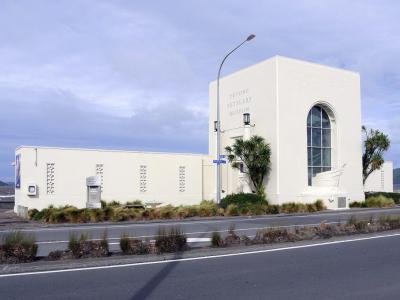
Petone Settlers Museum, Wellington
The Petone Settlers Museum, situated in Wellington, holds a significant role as a cultural and historical hub dedicated to honoring the arrival of the first European settlers in the region. These settlers reached Petone Beach on January 22, 1840, a pivotal moment in the area's history. The museum was established to commemorate this event and to celebrate the diverse migration, settlement, and cultural heritage that characterizes the Hutt Valley.
Occupying the Wellington Centennial Memorial Building, originally erected as a bathing pavilion, the museum enjoys a picturesque setting next to the Petone Foreshore. This location, overlooking the waters where the European settlers arrived, holds not only historical importance but also provides a scenic backdrop for the museum.
Functioning as a social history museum, it collaborates closely with the community, offering programs and experiences that explore settler and family histories, shaping the region's identity. Moreover, it serves as a valuable resource for genealogists, granting access to a database documenting passenger arrivals in Wellington Harbour from 1839 to 1897.
One of the museum's highlights is the audio-visual presentation, "A New Land, A New Hope, A New People." This enhanced exhibit, located in the museum's west wing, provides an immersive account of the New Zealand Company's first organized European settlement. It delves into the settlers' early experiences, their interactions with the Maori, and their personal narratives of settling in New Zealand. Accompanied by artifacts from their daily lives and images illustrating Petone's transformation, this presentation offers visitors profound insights into the challenges and successes of the early European settlers in New Zealand.
Adjacent to the museum stands a memorial commemorating the first European landing, further enriching the historical significance of the site and establishing a tangible link to the past. Together, the Petone Settlers Museum and its surrounding memorials serve as a testament to the lasting impact of the region's settlers, their stories, and the ongoing cultural diversity that shapes Wellington today.
Occupying the Wellington Centennial Memorial Building, originally erected as a bathing pavilion, the museum enjoys a picturesque setting next to the Petone Foreshore. This location, overlooking the waters where the European settlers arrived, holds not only historical importance but also provides a scenic backdrop for the museum.
Functioning as a social history museum, it collaborates closely with the community, offering programs and experiences that explore settler and family histories, shaping the region's identity. Moreover, it serves as a valuable resource for genealogists, granting access to a database documenting passenger arrivals in Wellington Harbour from 1839 to 1897.
One of the museum's highlights is the audio-visual presentation, "A New Land, A New Hope, A New People." This enhanced exhibit, located in the museum's west wing, provides an immersive account of the New Zealand Company's first organized European settlement. It delves into the settlers' early experiences, their interactions with the Maori, and their personal narratives of settling in New Zealand. Accompanied by artifacts from their daily lives and images illustrating Petone's transformation, this presentation offers visitors profound insights into the challenges and successes of the early European settlers in New Zealand.
Adjacent to the museum stands a memorial commemorating the first European landing, further enriching the historical significance of the site and establishing a tangible link to the past. Together, the Petone Settlers Museum and its surrounding memorials serve as a testament to the lasting impact of the region's settlers, their stories, and the ongoing cultural diversity that shapes Wellington today.
Want to visit this sight? Check out these Self-Guided Walking Tours in Wellington. Alternatively, you can download the mobile app "GPSmyCity: Walks in 1K+ Cities" from Apple App Store or Google Play Store. The app turns your mobile device to a personal tour guide and it works offline, so no data plan is needed when traveling abroad.
Petone Settlers Museum on Map
Sight Name: Petone Settlers Museum
Sight Location: Wellington, New Zealand (See walking tours in Wellington)
Sight Type: Museum/Gallery
Sight Location: Wellington, New Zealand (See walking tours in Wellington)
Sight Type: Museum/Gallery
Walking Tours in Wellington, New Zealand
Create Your Own Walk in Wellington
Creating your own self-guided walk in Wellington is easy and fun. Choose the city attractions that you want to see and a walk route map will be created just for you. You can even set your hotel as the start point of the walk.
Historical Buildings Walking Tour
The first immigrants to New Zealand brought along their sense of style. Most of the country's first settlers, if not all of them, were Britishers; the capital city was no exception. The latter fact is duly reflected in Wellington's historical architecture. These buildings offer a glimpse into the city's past and add a great deal of charm to the cityscape. Let's take a quick... view more
Tour Duration: 2 Hour(s)
Travel Distance: 3.5 Km or 2.2 Miles
Tour Duration: 2 Hour(s)
Travel Distance: 3.5 Km or 2.2 Miles
Wellington Introduction Walking Tour
Wellington is the capital of New Zealand and the country's second-largest city after Auckland. It also has the distinction of being the world's windiest city by average wind speed.
The city was designed by Captain William Mein Smith in 1840. He was the first Surveyor General for Edward Wakefield's New Zealand Company. The name comes from Arthur Wellesley, the first Duke of... view more
Tour Duration: 2 Hour(s)
Travel Distance: 3.6 Km or 2.2 Miles
The city was designed by Captain William Mein Smith in 1840. He was the first Surveyor General for Edward Wakefield's New Zealand Company. The name comes from Arthur Wellesley, the first Duke of... view more
Tour Duration: 2 Hour(s)
Travel Distance: 3.6 Km or 2.2 Miles


